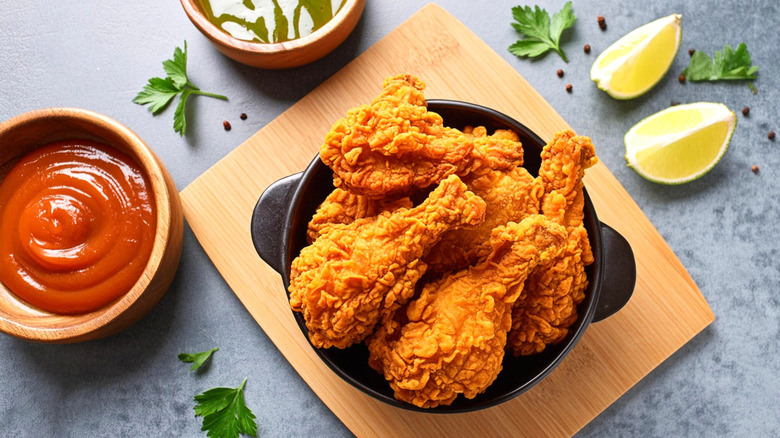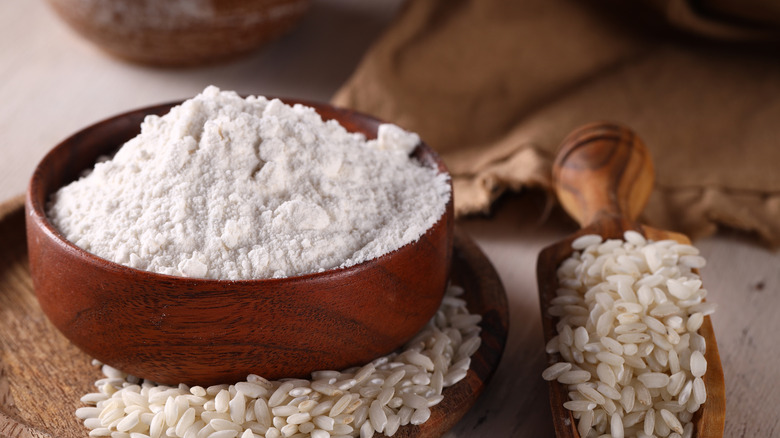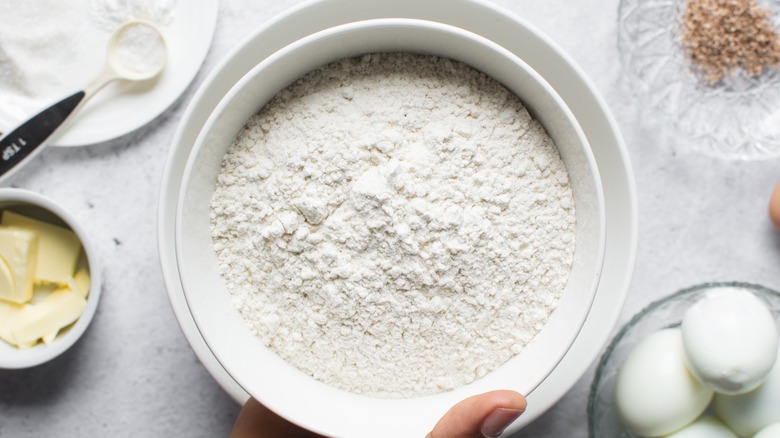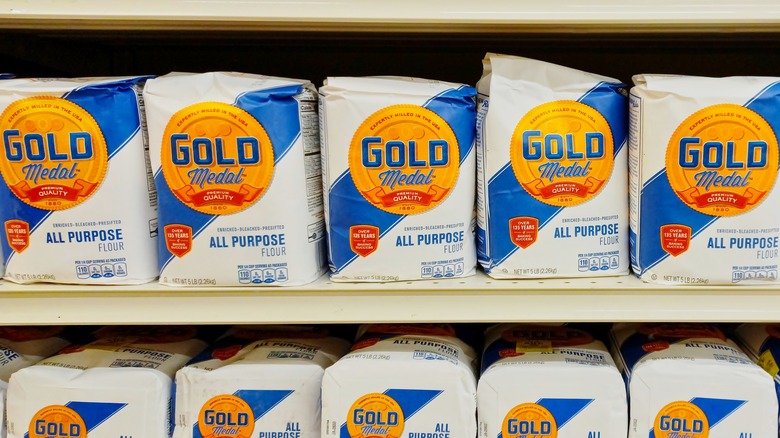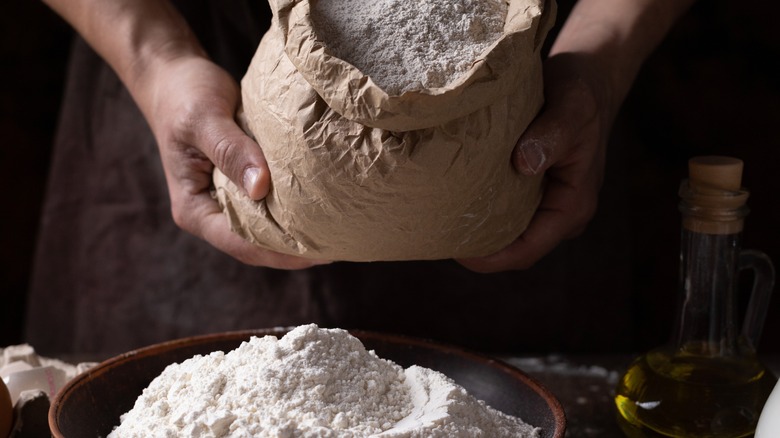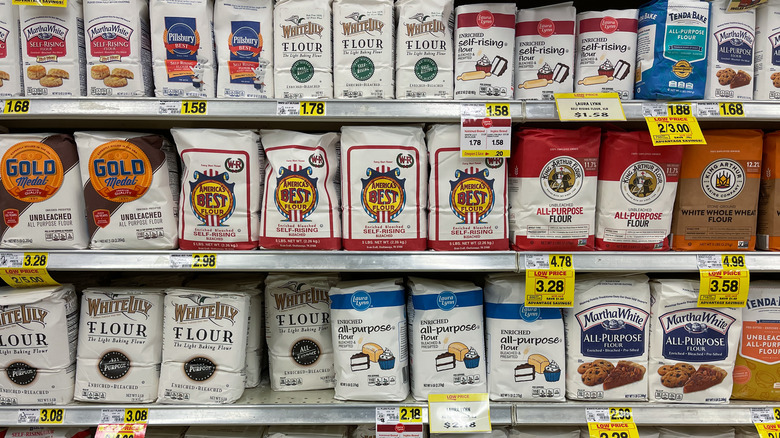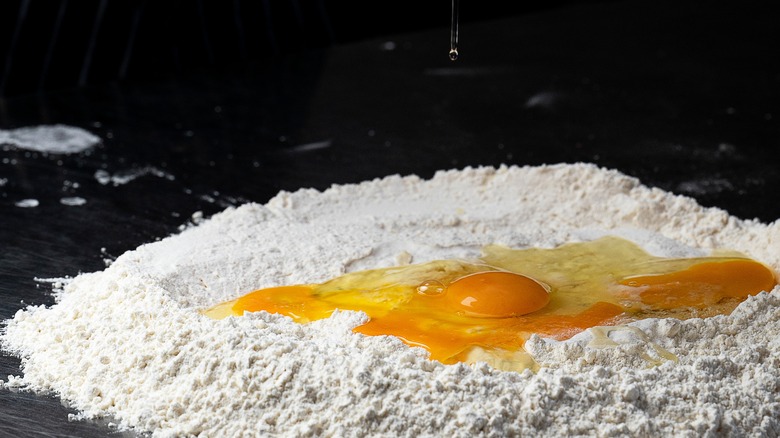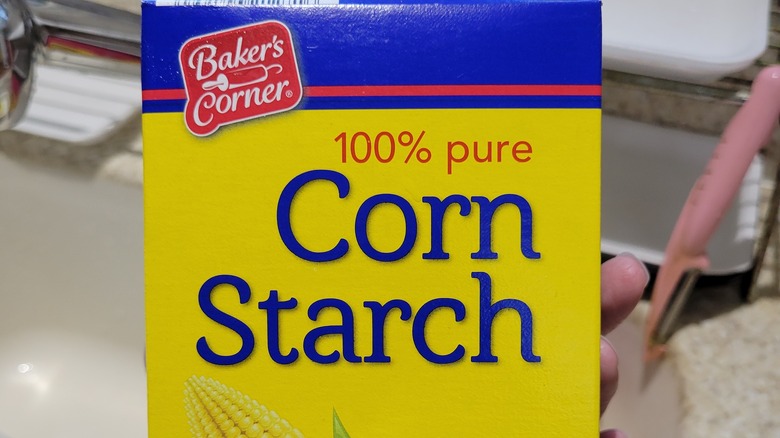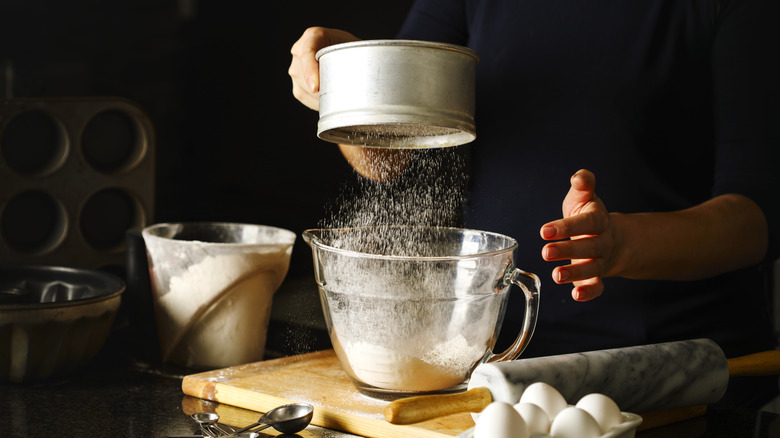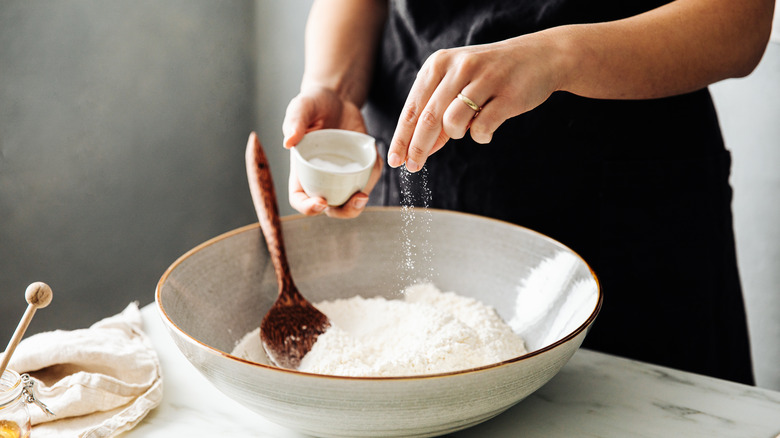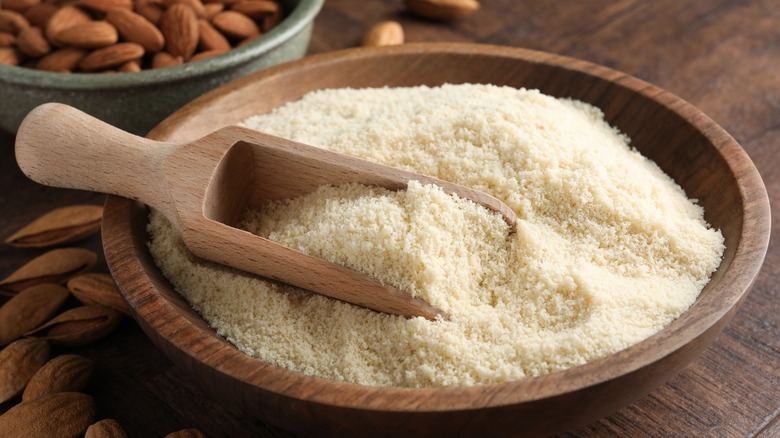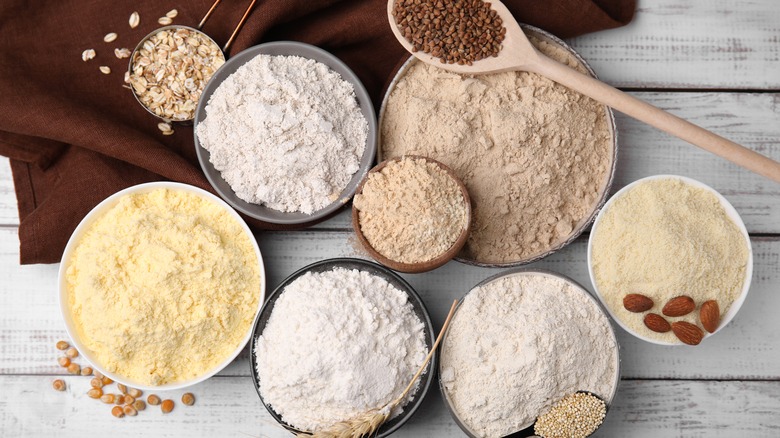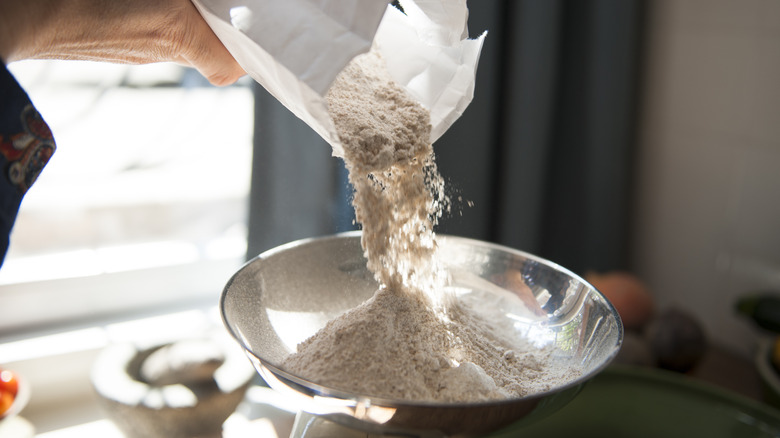The Best And Worst Flours For Making Delicious Fried Chicken
We may receive a commission on purchases made from links.
Nothing beats crispy fried chicken. Whether you're serving your poultry in a sandwich or as the main entree, your serving options are endless. There is a multi-step process from the brine to breading to the frying, all of which goes into getting the perfect crunch. "The quality of the bird is very important, but how you blend your spices and flour, along with how you marinate your chicken, is the most important factor to create the perfect fried chicken," said Scott Duke, chef at The Colonnade in Atlanta, adding that the first bite needs to be perfect.
After you select a salty brine, your next major choice is what you will choose to bread your chicken with. There are many options for breading chicken. This is especially true even down to the flour — as flour is a key component to making a foolproof fried chicken with a good texture. "It determines the outcome of the texture and provides a layer between the hot oil and chicken," said celebrity chef, James Beard award-winner, and restaurateur Art Smith. "I call it 'winner, winner chicken dinner' — the first crispy crunchy bite into the tender and juicy cooked chicken. Heaven."
Your choice of flour, along with how much breading and how you cook your chicken, can be the difference between a lackluster dish and fried chicken heaven. We spoke with experts to get the scoop on what the best flours are for making perfectly crisp fried chicken, and what flours you should avoid.
Best: Rice flour
Rice flour tops the list of the best flour options for many chefs. Rice flour doesn't absorb as much oil as other flours (50% less oil absorption than wheat flour, according to the Southern Regional Research Center). Less oil means fewer opportunities for greasy chicken and you get a crispier crust packed with just enough flavor to not overpower the chicken's natural taste. Rice flour is an especially popular choice if you are looking to recreate a fried chicken with an Asian flair like Korean fried chicken. A combination of rice flour and cornstarch can yield a light and crisp tempura-like coating – with the crunchy texture holding up even if you add sauce to your chicken after frying.
One of the biggest bonuses of rice flour is that it is gluten-free, meaning it is an ideal choice for those with gluten sensitivities. While your flour choice may not make or break the nutritional profile of fried chicken, it can be helpful to know some basics. Rice flour is also higher in calories, carbohydrates, and glycemic index. Another consideration is that rice flour is typically more expensive than other flour varieties. However, buying in bulk may offset some of that cost.
Worst: Highly processed white flour or bleached flour
Experts have warned about using highly processed or bleached white flour. Highly processed white flour can lose many nutrients in the refinement process, leaving behind flour high in calories with few nutritional benefits like fiber, protein, or fat. While the amount of flour used in fried chicken coating is minimal, processed white flour can also create a spike in blood sugar – not ideal for those with diabetes and heart disease.
While Shawn Matijevich, lead chef-instructor of Online Culinary Arts and Food Operations at the Institute of Culinary Education, noted that there may not be one specific flour type that should be avoided more than others, you may want to be mindful of that bleached versus unbleached label on white flour. "I typically avoid bleached flours," he said. "But beyond that, using a single flour is typically not the way to go if you want a great crust."
What makes flour unbleached is the natural aging process after milling, causing oxidation and white color to occur. Bleached flour yields the same white color results using chemicals to speed up the oxidation process. Those chemicals can include chlorine dioxide, benzoyl peroxide, chlorine gas, and the controversial potassium bromate. Though these additives are not prohibited, some people with a sensitive palate may be able to detect a certain aftertaste, particularly in baked goods. There is also a slight cost difference typically with bleached flour being faster and therefore cheaper to produce.
Best: All-purpose flour
All-purpose flour is a staple pantry item that is easily found in stores. Its versatility, as well as its capability to get buttermilk and seasonings to stick, make it a popular choice for breading to get that desired crisp crust on your chicken. "Using all-purpose flour allows you to have a clean base for seasoning and will hold up when cooking at a high temperature to make sure the crust does not burn or flake," explained Scott Duke. All-purpose flour is typically a cheaper option than specialty flour. It also contains a lower amount of calories and carbs than other flour options.
There are many all-purpose flour options to choose from. "If you were to make fried chicken like ours, we'd suggest Gold Medal flour, but any all-purpose flour will get the job done," Duke said. "What matters more is what spices you incorporate into your flour to provide taste." Dried herbs and spices like paprika, garlic powder, onion powder, cayenne pepper, turmeric, or dried oregano are a welcome flavor addition to the flour – the fresh versions make a good garnish.
Ultimately, the flavor profile is up to your personal preferences. "I know cooks who make delicious fried chicken using only all-purpose flour. Use what works for you," said Art Smith. "You can go to any church social across America and find dozens of different types of fried chicken. They are all good. None better than the other. That's the joy of cooking in this diverse country."
Worst: Bread flour
Experts gave bread flour a resounding "no" for frying chicken. Though it is considered a specialty flour, as the name states, bread flour is best utilized in baking bread. It has the highest protein content of all flours (12-14%), forming higher gluten in your dough, making it a strong, stretchy flour to help bread hold its tall loaf-like shape. While bread flour has numerous benefits for baking, it does not make an ideal fried chicken coating. "The gluten content is simply too high. All the wonderful aspects of bread flour for baking do not translate to coating and frying chicken," said Art Smith. "Once it hits the heat of the oil, the skin can become tough and chewy and, in my experience, won't crisp to what I think the coating should be."
All that being said, there is some room for substitution in a frying situation. However, you want to be aware that bread flour absorbs more liquid than all-purpose flour, so recipes may require slightly more liquid. As for baking with bread flour, experts recommend following flour suggestions in recipes and using bread flour when recommended.
Best: Self-rising flour
Self-rising flour is up for debate depending on who you ask. For Art Smith, self-rising flour is one of two flours he considers a must for fried chicken. "All flours are not created equal, but all have their purpose in the kitchen," he said. "For fried chicken, I use a combination of all-purpose flour and my Southern favorite White Lily. [All-purpose] is a blend of hard and soft wheat and White Lily is a 100% blend of soft red winter wheat. White Lily has a finer mill and lovely soft texture."
Self-rising flour is white flour with baking powder and salt. "It naturally gives that rise to the coating and crisps perfectly," Smith said. Self-rising flour is also easy to find both in stores and online with multiple brand options compared to other specialty flour. And you can even make your own self-rising flour by adding your own baking powder and salt.
However, some chefs like Scott Duke said they avoid self-rising flour. It should be noted that self-rising flour contains a lower protein content than generic all-purpose flour, so you may notice a slightly different crumbling than if you use Duke's preferred option of all-purpose flour. "Other flours typically have other ingredients that could mess with the flavoring of your chicken or the way the crust cooks and its appearance," he said.
Worst: Pasta flour
Pasta flour likely isn't on your radar unless you plan on making your own homemade pasta. However, if you happen to have pasta flour in your pantry, experts say to pass on using it to bread your chicken for the fryer. A well-known Italian pasta flour is the 00 flour, which gets its name from its rating by how finely the flour is sifted. It is made from soft wheat or durum wheat, and the fine texture is similar to cake flour or pastry flour.
The grind size also affects the flour's moisture properties, which means it may not stick to your chicken as effectively. "[Because] 00 flour is very fine ... you may find that the crust would flake or fall off if used," said Scott Duke. Due to its difficult texture for breading, save your pasta flour for pastries, flatbreads, or fresh pasta, and avoid it for uses like bread, pizza, and most importantly — frying chicken.
Best: Cornstarch
If you love a super crunchy fried chicken crust, cornstarch is one of the best options for dredging. Though cornstarch is known for thickening sauces or soups, it has a place in the kitchen for fried chicken. Cornstarch absorbs extra moisture (a must for a crisp crust if you marinate your chicken first) while helping your chicken be thoroughly coated. You can expect a browned, crunchy exterior — especially when it is the sole breading ingredient like Korean or Japanese-style fried chicken. You should also be aware that cornstarch may speed up the cooking time, as you may find smaller pieces of chicken fried only in cornstarch crisps up shortly after being dropped in oil.
Cornstarch can also be used in tandem with all-purpose flour in a 50/50 ratio or just subbing out a small amount of flour with it. Cornstarch prevents gluten development, weakens the flour's protein, and makes it tender. This can result in a different texture than when using just one type of flour. "You can use a combination of rice flour and cornstarch for a lighter coating like a tempura," said Art Smith. "It's just not my preference for chicken."
Worst: Cake flour
Cake flour is another option that is great for baking, but not so ideal for frying chicken. It is one of the lowest protein flours (around 7-9% versus all-purpose flour's 10-12%) that is finely milled. In fact, cake flour is so fine that it is required to be sifted before use due to its texture so it doesn't clump together. Cake flour differs from all-purpose flour largely because it is made from soft wheat and has less gluten, which leads to more of a softer and more delicate crumb texture in baked goods.
Many of us love fried chicken for its super crispy crust, and using cake flour for breading may not live up to our expectations. However, if you have your heart set on cake flour for dredging your fried chicken, just know that you may end up with more of a batter for deep frying instead of a dry breading consistency.
Best: Combination of all-purpose and non-gluten flour
Trying to find the perfect flour for fried chicken can be quite the experiment. This is why after testing, many chefs recommend a combination of flour types like all-purpose and another non-gluten flour option. "A ratio of 70% all-purpose flour, 20% masa harina, and 10% cornstarch is what I use," said Shawn Matijevich. "Incorporating non-gluten flour like potato flour, cornstarch, or tapioca gives you some very nice crispy elements in the breading that you wouldn't get with flour alone. This is because right after frying, the flour immediately starts absorbing liquid from the interior." Masa harina is dried and powdered corn dough that is processed to break down the corn kernels. It is naturally gluten-free and popular in Mexican cooking.
This flour combination is one example of how you can test out options to find what works for you — Art Smith encourages creativity in the kitchen. "I have a friend who uses 1-part all-purpose flour to 1-part ground cornmeal [for] extra crunch. Consider a little panko as well," Smith said. "It's your kitchen, your rules." Despite the flour choice, Matijevich warns the cooking technique matters when trying to replicate your favorite restaurant fried chicken. "The best fried chicken joints use pressure fryers which are pretty out of reach for home cooks. If you want a good quality outcome, use a blend of flours similar to what I mentioned above with a fairly low heat (320 degrees Fahrenheit)," he said.
Worst: Almond flour
Almond flour has grown in popularity in gluten-free and grain-free baking circles for its rich flavor and fine texture. It can be made at home by blanching and peeling the skin-free almonds or purchased in the store (though it can be more expensive, as it is considered a specialty flour). Almond flour may be a good choice for those on a specific diet like keto or paleo. It is packed with protein, fiber, and good fats. However, almond flour can be tricky to use for frying, as it burns more easily than normal flour.
If your oil heat is too high and you don't keep a watchful eye during the frying process, your almond flour-coated fried chicken may end up with a burnt crust. In order to decrease the risk of inedible fried chicken, stay away from almond flour for dredging unless you really need to, and use your almond flour for making scrumptious cookies or scones instead.
Best: Gluten-free quinoa flour combination
This is another great option for our gluten-free fried chicken aficionados! Luckily, there are plenty of options nowadays for breading without gluten for fried chicken both at home and in restaurants. "We use a combination of quinoa, millet, and chickpea flour for our gluten-free fried chicken breading," said Jon Sloan, executive chef at The Crack Shack restaurant, which has locations in California and Las Vegas.
Quinoa flour is ground into fine powder from quinoa, a gluten-free seed, and has a nutty, earthy flavor. You can find higher levels of fiber, iron, protein and unsaturated fat in quinoa flour. Quinoa is also known for its digestive health qualities and anti-inflammatory properties. Another similar gluten-free option is chickpea flour, made from dried garbanzo beans. Chickpea flour has a nutritional boost, a lighter texture, and a golden hue that matches the deep crust color desired in fried chicken. When used for frying, you may find that chickpea flour's binding properties make more of a batter than a powder breading. Though these specialty flours may be a bit more expensive than all-purpose flour, abiding by dietary restrictions (and buying in bulk) makes it worthwhile to enjoy delicious fried chicken.
Methodology
To come up with the best and worst options for flour when frying chicken, we spoke with chefs whose expertise extends to fried chicken to get their professional opinions. We also took dietary restrictions, nutritional value, pricing, and availability in stores or online into consideration.
Experts did note that the nutritional value shouldn't be the deciding factor for the flour you select to dredge your fried chicken. "The breading is such a small portion of the overall recipe," said Shawn Matijevich. "I don't think the nutritional needle will move very much based on the flour you choose."
No matter what flour you end up using, your fried chicken should be a comfort food catered to your personal preferences. "We've always considered that there are nutrients for the soul too ... a pleased belly, a hearty laugh and happy smile," said Scott Duke. "These things can't be measured on the side of (the) box in the ingredients!"
